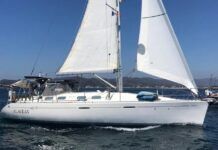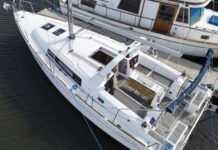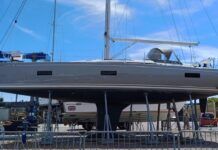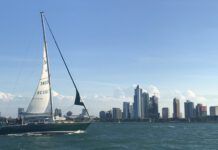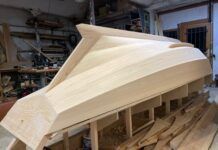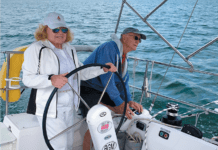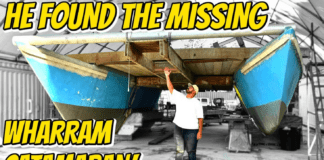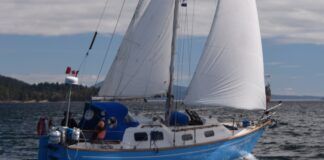Summers are hot in Florida but never so much as just before a storm. The humidity can be so oppressive that windows will fog on the outside of an air-conditioned car. It was like that near the end of June, 1998.
Thunderstorms usually roll in during the late afternoon and can be heard before they are seen. The rumbles are distant, continuous, wavering, and increasingly loud. Then the skies begin to darken. It wasnt like that on this, the last day of the hottest month on record.
Maybe it was El Nino. Maybe it was the late day sun or maybe it was the pall that hung in the air because of endless brush fires, but on this day the storm came in silence. Westward, the sky was blue, brilliant and hot.
Eastward, it was black like the ink of night rolling across the land to consume what was left of the day.
Sea gulls could be seen as brilliant white specks perhaps five miles away, cavorting in the face of the storm. The bottoms of the clouds resembled row upon row of giant Parker House rolls burnt to a crisp. This was extremely turbulent air, yet on the surface, it was dead calm. Not a breeze. Not a ripple anywhere.
A lone mullet jumped out of the water to see what was going on.
Time to install the lightning chain. It was one of those things I had put off because it hadnt rained for weeks. The brass chain had vanished. Who knows how. It left no burn marks. Now I had a steel chain which will rust and leave marks, and I hate that so I had put it off.
I also hate installing the chain in the face of a storm. You never know when the boat will get hit. Do you connect it to the mast first and then put it over the side, or do you put it over the side first and then connect it to the mast? Either way can get you dead.
Yet, I figured that this storm was coming quietly so it shouldnt be a problem. I dug out the chain and was halfway up the walkway under the eave of the pilothouse roof when the first bolt hit. Well. it didnt exactly hit. It went up from a smoldering palm tree a block away. It was the first one I ever saw actually go up.
And it was green. Not blue. Not white. Grass green.
Two closer ones went up before I managed to deposit the chain on the afterdeck and flee into the pilothouse. For 20 minutes, bolt after bolt discharged upward in a surrealistic green fireworks display I had never before witnessed. They were so frequent, the noise never let up. The sound was deafening. Like shotgun blasts. Some of them had no rumble afterward because another blast drowned out the sound.
Then another and another.
I positioned myself equidistant from all the shrouds and chainplates and there I froze.
It was over about as quickly as it started. The inky clouds rolled westward and blotted out the sun. The eastern sky began to lighten. The air was cooler and there was barely a breeze. It smelled like a mixture of burning wood and ozone. Not a drop of rain had fallen.
I decided to connect the chain anyway but then I heard the frying. Every turnbuckle, every chainplate, the spreaders and every piece of rigging, including the pointed radials I had mounted on the masthead for just this kind of occasion, were sizzling with static discharge. Had it been night, Im sure they would have glowed blue. Or maybe green. This storm was different.
Ralph, my neighboring powerboat friend, emerged from his air-conditioned cabin in a sweat because the shore power had gone out.
Hey! I called. Did you see the color of that lightning?
Nah, He grumbled. Youre the only idiot around here who would stand outside and watch that stuff.
Okay, so maybe I did look a little ridiculous standing there holding 20 feet of chain. But thats not why I didnt defend myself. There was no way I could have said anything with a straight face to a guy with shoulder-length hair doing an incredible imitation of a dandelion.
-RW
Hit On Green Bay
Reading contributing editor Richard Wilkens terrifying account of lightning on the West Coast of Florida, reminded me of the time my boat was struck while cruising Green Bay, Wisconsin (the water, not the town!).
In the late 1970s I owned a Pearson Triton, home port White Lake, Michigan. One summer, my cousin Tony and friend Frank took her across Lake Michigan to Green Bay. We were heading south, inside the Door Peninsula, when a thunderstorm approached from the west. Anticipating a squall, we furled the sails and started the engine. Tony was at the helm, so Frank and I ducked below into the cabin.
Lightning began to strike, closer and closer. The last one hit the masthead. I remember seeing the VHF antenna fly through the air, landing in the dinghy. The clap seemed to lift the bilge boards on which we stood.
At the Palmer Johnson yard we took stock of the damages. The battery case had been blown apart, though it still held a charge. The knotmeter and depth sounder were fried. And the points on the Atomic 4s distributor were burned. Fortunately, the rig was grounded and there was no structural damage to the hull or deck.
Other than that, the only real damage was to our ears. When lightning strikes that close, you can not do other than to blink and cringe. I have a photo I took of Tony reacting thusly at one of the earlier strikes.
Fearful as lightning is, I am comforted knowing Man cannot fully control Mother Nature.
-DS





